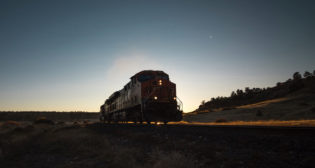
CEO PERSPECTIVE: A Growing Rail Industry Needs Policy Sanity
Written by Ian Jefferies, President and CEO, Association of American Railroads
Ian Jefferies, President and CEO, Association of American Railroads
As part of a special series in Railway Age’s March 2022 issue, 11 North American railroad CEOs address what must be done to grow and gain market share from competing freight transportation modes. Ian Jefferies, President and CEO of the Association of American Railroads, is the 10th to share his perspective.
Rail transportation remains a focus in Washington—especially relevant for our industry as we navigate continued volatility and work toward continuous growth into the future. Readers of this publication understand what growth will entail in a nation where freight demand will grow by 30% over the next 20 years: capturing market share in mileage bands today dominated by trucks, increasing end-to-end visibility and predictability for customers, and continuing to innovate to improve safety and efficiency. As society and businesses increasingly focus on ESG, the freight rail sector’s emissions profile, as well as its own carbon reduction progress, will also position the companies I represent to spur U.S. growth.
However, a professed preference for rail among policymakers and well-understood goals to reduce emissions and bolster supply chains are at times frustratingly inconsistent with the policy agenda of some in charge. To be clear, establishing a regulatory paradigm to encourage freight rail growth in the near and long term requires policy congruity.
Take, for instance, the forced switching proceeding at the U.S. Surface Transportation Board (STB). Spurred by the recommendations of the National Economic Council in a sweeping executive order, the STB could finalize a proposed rule, spurred by large shipper special interests, even though it is six years old and rooted even older. Observers note that widespread forced switching would gum up the network and reduce investment (as a result of reduced revenues and because investors aren’t keen on subsidizing competitors)—clear challenges for the White House Supply Chain Task Force, where the sole focus is maximizing goods movement and network fluidity.

Environmentalists have taken note, too, as groups such as the National Wildlife Federation reinforced a logical point made by scores of Congressional Democrats last year: market intervention that makes rail less competitive will only lead to freight transportation in more carbon intensive modes. This is not promoting competition, it is perverse policymaking at its worst, hence why labor unions, economists, passenger railroads, intermodal shippers and a range of other interested parties also oppose the proposal.
Or, consider that the Federal Railroad Administration—the nation’s rail safety regulator—continues to discourage data-proven Automated Track Inspection (ATI) technologies as it embarks on another minimum crew-size standard devoid of one iota of data to justify it. Putting aside that ATI in some cases has reduced track geometry defects by 90%, the technology also increases supply chain fluidity, a requirement for growth. The same logic applies to PTC, which most will agree has been a success to date and equally predict will evolve over time to expand capacity—another way for railroads to grow.
And yet despite the lip service given to promoting rail, the industry today faces a Luddite policy environment antithetical to innovation, destined in time to shift at least some freight to trucking competitors racing toward electrification and automation at the encouragement of the very same policymakers. Once more, the left hand in Washington seems to be at odds with the right.
Despite these pitched regulatory fights, there are bright spots coming out of Washington, D.C. Railroads were encouraged by the passage of the bipartisan Infrastructure Investment and Jobs Act, or IIJA, in 2021. While Congress must return to a user fee model that removes market-distorting highway subsidies over the long term (the legislation included a $118 billion transfer from the general fund to the Highway Trust Fund, totaling out at $275 billion since 2008), the IIJA included a national Vehicle Miles Traveled (VMT) pilot program, a first-of-its-kind grade separation program, and moneys for multimodal freight projects. Certainly railroads, their customers and the communities in which they operate will reap the rewards of this legislation.

Notably, the five-year surface reauthorization avoided significant truck size and weight increases pursued not by truckers themselves, but by the very same shipping interests seeking forced switching, that would only further undermine the multimodal competitive playing field and exacerbate the underpayment of over-the-road freight shipments. This, as has been well researched over the years, is good news for growth, too. Creating a system whereby trucks pay a weight distance fee that captures their full impact will level the playing field and create needed parity.
Additionally, the continued ingenuity of railroads to pursue alternative-fuel locomotives as well as battery-electric power sources will help attract businesses keen on carbon reduction and minimizing impacts on local communities. The industry is pleased with the establishment of several new programs in IIJA and via the appropriations process that create new public-private partnership and R&D opportunities for railroads, all of which will propel railroads to a new era while at the same time supporting customers.
Railroads are excited about the future. We work tirelessly to capture growth every day as customers expand facility areas, locate on freight infrastructure, or shift to rail from other modes to reap cost and environmental advantages. Now we need consistency from policymakers.
Read more of Railway Age’s special CEO Perspectives series:
• Katie Farmer, BNSF: Sustain a Growth Mindset
• Keith Creel, Canadian Pacific: Supply Chain, Market Reach and Sustainability
• JJ Ruest, CN: Railroads Must Lean Into Their Natural Strengths
• Jim Foote, CSX: Performance, Sustainability, Innovation Are Keys to Growing Market Share
• Pat Ottensmeyer, Kansas City Southern: Competing on a Global Scale
• Alan Shaw, Norfolk Southern: A Simple, Powerful Recipe for Growth
• Lance Fritz, Union Pacific: Solving Customer Problems at the Heart of Innovation
• Peter Gilbertson, Anacostia Rail Holdings: Growing With People
• Dan Smith, Watco: Stay Close to Your Customer
• Chuck Baker, American Short Line and Regional Railroad Association: Four Parallel Paths to Growth



